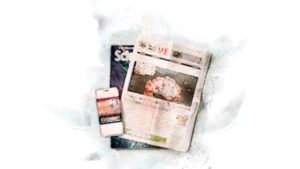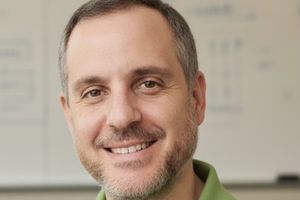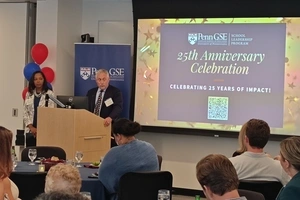The time was normally set aside for science class. But, “for the next 30 minutes,” teacher Mia Blitstein, GED’02, told the 18 middle school students at Global Leadership Academy, “this is going to be a newsroom.”
Students at the West Philadelphia charter school scrambled over notes and prepared for interviews for their publication, The Healthy Globe. Instead of a class with their regular teacher, they were going to have what they call “newspaper time.”
Blitstein, who got her master’s in elementary education from Penn GSE, works with Healthy NewsWorks, a nonprofit that that teaches health and media literacy to students as young as first grade.
“We have the youngest reporters in the country,” said health journalist Marian Uhlman, who started the organization in 2003 along with a second-grade teacher.
Uhlman said that this school year, Healthy NewsWorks expects its newspapers will reach more than 6,000 students in under-resourced public, private, and parochial schools. Blitstein and other teachers are currently working in 18 schools, helping students prepare newspapers that cover topics ranging from interviews with health professionals to public health issues and their own personal health experiences. And they are teaching research and journalistic skills in the process.
They are, for example, teaching students what a reliable source is, how to spot agendas behind an online post, and how algorithms can platform just one side of a story. They also hold workshops with teachers and prepare sample lesson plans, some of which are available for free on their website for anyone to use.
“Healthy NewsWorks believes that every child has the right and the need to acquire health knowledge and literacy skills,” said the organization’s statement of purpose. (Projects go beyond written work, too. Their students’ documentary film, How We Heal, won the media award at the San Diego International Kids Film Festival in 2022.)
Blitstein and Healthy NewsWorks are part of a growing media literacy movement in schools and universities throughout the nation. Penn GSE graduates and faculty members have played a key role in the movement, including T. Philip Nichols, G’16, GR’18, who has chronicled its history, Alesha Gayle, GRD’12, who teaches it to graduate students, and Blitstein, who exposes young learners in elementary and middle schools to it.
Across this range of academic settings, practitioners try to help students and others navigate their way across an increasingly complicated media landscape. Thanks to the internet and social media, news consumers are now inundated with online information, much of it unsupported by evidence. The working definition of the term “media literacy,” established at a watershed 1992 conference at the Aspen Institute outside Washington, DC, is “the ability of a citizen to access, analyze, and produce information for specific outcomes.” But it was the 2016 presidential campaign that brought phrases such as “fake news” and “alternative facts” widely into the public sphere, Nichols said, accompanied by increased polarization among news consumers and a flood of dubious information online.
In a 2020 report on this polarization, the Pew Foundation found that “Republicans and Democrats place their trust in two nearly inverse news media environments. … Evidence suggests that partisan polarization in the use and trust of media sources has widened in the past five years.”
Some states (including New Jersey and Delaware) have passed some sort of legislation requiring that media literacy be part of school curriculums. Pennsylvania is currently considering such a bill, and Gov. Josh Shapiro voiced strong support for it in his February budget address.
THE CAMPUS CLASS
“I’ve had graduate students who never set foot in a library,” said Gayle, a senior fellow in Penn GSE’s Learning, Teaching, and Literacy division who has taught the course “Critical Media Literacy in the Age of Trump.” “They’re just looking online.” She said that 86 percent of people under the age of 22 depend primarily on the internet for news.
It’s a landscape of paradoxes. “The younger they are, the more likely they are to believe questionable information,” Gayle said. And while younger students are more sophisticated about using social media, she said, they can be very unsophisticated about what goes into what they’re watching, reading, or hearing.
Gayle borrows a metaphor from The Wizard of Oz: “They don’t know who’s behind the curtain … whose voices are being highlighted.” Or “how people massage the truth … how the people who produced [an ad] wanted you to interpret it.”
Her course has included analyzing Kentucky Fried Chicken advertisements in different countries and exploring the different ways the same story was treated by The New York Times, The Washington Post, and other major media outlets. “I’m teaching them to consider authorship,” she said. “Who’s paying for the message and what is their agenda? What about the author’s other work on the subject?”
According to a March 7, 2024, New York Times story, a handful of “news” websites had popped up in recent weeks with names like the “Chicago Chronicle” or the “Miami Chronicle.” “In fact,” the Times story stated, “they are not local news organizations at all … they are Russian creations, meant to mimic actual news organizations.” Could a student who had taken a good media literacy course be better able to spot them as fakes?
“I would hope so,” Gayle said.
THE HISTORY OF THE FIELD
Nichols, whose Penn GSE doctoral studies focused on literacy, culture, and international education, is now a media scholar and associate professor of education at Baylor University in Texas. He focuses his research on how science and technology shape the ways we practice, teach, and talk about literacy, and the implications for equitable public education.
As one of the country’s leading scholars on the history and development of the media literacy movement, Nichols’ work cuts across almost a century of information and misinformation. In his 2016 publication “Media Education and the Limits of ‘Literacy,’” he provides historical context for how “media literacy” as a field came to focus on “strategies for identifying and critiquing media bias and misinformation,” and “equipping youth to produce media messages that challenge misinformation or represent marginalized perspectives.”
The media literacy field, said Nichols, was only firmly established in that 1992 Aspen Institute conference. But there were earlier versions of “media education” that went by different names and focused on different skills, that may offer valuable lessons for today.
“One lesson has to do with how misinformation becomes available in the first place,” he said. “Not just addressing misinformation, but the atmosphere that fosters it. We’re trying to teach students to be critical researchers of the media environment that surrounds them.”
There’s a tendency today, he said, to focus on vetting media messages, but this can overlook important details about the technologies and industries that also shape the information that circulates. “Understanding the media environment itself, not just isolated messages, is something that previous generations of media education have emphasized, but that we sometimes neglect today,” he said.
One example he gives is that rather than learning to analyze a particular news article’s message, students should be asked to explore the contexts in which people might encounter the article—the algorithmic rankings that boost its presence on a newsfeed, the forms of positive or negative engagement that drive or inhibit its spread on social media, and the profit motives of authors, publishers, and digital platforms involved in its circulation.
That task has become more difficult in the past few years, he said, thanks to the creation of websites that spread false information to generate “clicks,” and thus, revenue.
Nichols said that, historically, research on the subject of media literacy “wasn’t always immediately relevant to practicing teachers.” Now, as textbooks on the subject become more common—search the term “media literacy” on Amazon and you get dozens of results—he hopes that it can be integrated into all academic subjects, not just English or language arts.
One sign of how public consciousness has embraced the concept of—or necessity for—media literacy? Oxford Dictionaries named “post-truth” its word of the year in 2016. Defined as “relating to or denoting circumstances in which objective facts are less influential in shaping public opinion than appeals to emotion and personal belief … the concept has been in existence for the past decade, but Oxford Dictionaries has seen a spike in frequency this year in the context of the EU referendum in the UK and the presidential election in the US.”
Around this time, Nichols said, the term “fake news,” which had been around for years, “takes off with a life of its own.” Whether it’s called media literacy or one of various names that media education has had over the years, he said, concerns about it are more likely to surface in times of political crisis.
HEALTHY HABITS START YOUNG
Blitstein, from Healthy NewsWorks, seemed destined for her work as a media literacy educator. “I was practically born in the library,” she said. “My mom worked there,” in the central branch of the Free Library of Philadelphia.
She majored in children’s literature as an undergraduate at the University of Pittsburgh, and then worked in Philadelphia schools and at the nonprofit Children’s Literacy Initiative before coming to Healthy NewsWorks in 2018.
At Penn GSE, Blitstein said, “Kathy Schultz was the literacy professor who I remember fondly, and Janine Remillard was my math professor who opened my eyes to the beauty of different problem-solving methods. Sadly, I cannot come up with the name of the social studies professor who I remember messaging to us to make sure to think about who is outside of the photos we use as historical documents, and invited us to ask questions such as, ‘Who is behind the camera? Who is just outside the frame?’”
She was drawn to Healthy NewsWorks by its combination of coaching and curriculum. (She was also inspired by its focus on health education, as a survivor of non-Hodgkin lymphoma.) The basic lesson plans are aligned with Common Core State Standards and the students start out with a two-week “boot camp” to learn basic journalism concepts, such as “What is a reliable source?”
Students at each school prepare a newspaper three or four times a year that is printed for every student and staff member in their school. Healthy NewsWorks hopes this helps spread health knowledge in the community and increase the students’ sense of pride in their work, in addition to helping them grow their literacy skills and become better news consumers.
Blitstein might get to any given school once a week throughout the year, but the goal is that eventually the teachers in those schools master media literacy concepts enough to integrate them into their own lesson plans.
Across the Delaware River in Camden, New Jersey, at the Saint Joseph Pro-Cathedral School, the students are engaged with Blitstein and Healthy NewsWorks’ curriculum. Julian, a 13-year-old eighth grader, said he had learned a lot about asking questions and interviewing sources. Holly, another 13-year-old eighth grader, said that one of the biggest things she learned is “how we can give back” to the community with the newspaper. She also said she had been surprised to learn how complicated the news-gathering process is and the time it takes.
That is what Blitstein is hoping Healthy NewsWorks can do—not just teach young learners the work that goes into crafting news stories, but also help them understand the value of that work.
“The kids are excited about writing,” Blitstein said. “They’re more able to advocate for themselves and for their communities. And they won’t be easily swayed by what is deceptive. Being a reporter puts them in the driver’s seat.”
Media Inquiries
Penn GSE Communications is here to help reporters connect with the education experts they need.









